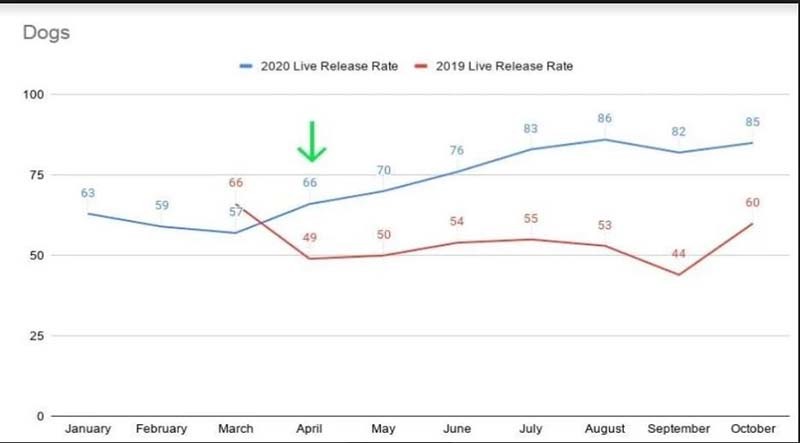This is part two of a two-part blog on building and maintaining successful transport partnerships. This blog is focused on tips for destination shelters—part one focuses on tips for source shelters.
Whether you’re just starting a transport program or have been transporting for years, there’s always room to grow and maximize your lifesaving impact. Here's the top 10 tips all destination shelters should know for successful transfer partnerships.
For partnerships to be truly equitable, just transporting animals in is not enough. The burden of transport costs, vetting, and transportation logistics should be shared between both source and destination organizations.
Finding ways to give back to the source community is extremely important. St. Hubert’s Animal Welfare Center provides monetary support and has created a give-back program for all the animals that are transported to them.
Consider meeting your partner halfway to cut down on transport costs and travel time like Animal Friends Alliance often does.
The traditional transport partnership has historically been very limited—just sending and receiving animals. Think about how you can take your partnership to the next level and make the most impact.
We love how the Animal Adoption Center in Wyoming helped secure funding to fully sponsor monthly spay/neuter clinics at one of their partner source shelters in Texas. Think about creative fundraisers you can host or promote to raise funds to offset the costs of transport, so the burden is not on your source shelter partner.
Making deeper connections with your shelter partners will lead to more fulfilling connections and a bigger lifesaving impact.
As we get comfortable in our routines with partners, it’s easy to forget to scrutinize our protocols. If intake criteria are too rigid you could be closing the door on partners and your ability to save more lives.
Do your under-resourced shelter partners really have time to provide video interactions of every large dog? Are you asking source partners for mandatory two week fosters prior to transport? Could you let your source shelter partners curate a list of potential transport candidates versus picking out each individual animal?
Strict intake requirements are not feasible for many source shelters, and it’s important to evaluate how we can be more flexible. Consider sending a transport survey to your source shelters to identify any barriers.
It’s important to remember that we don’t always understand the complexities or the struggles of our source shelter partners. Avoid negative partner talk like, “We saved these cats from that horrible shelter,” or, “So glad we got them out of Texas”.
Making sweeping statements about an entire shelter and their community is discriminatory, and if we want to have more compassionate transport partnerships, it’s important to truly value our partners and their communities. We love how One Tail at a Time in Chicago describes transporting dogs from their Tennessee partner as an honor.
Examine your processes and ensure that you’re responding to your source shelters as quickly as possible. It’s hard to imagine, but many shelters are so full that sometimes dogs and cats only have a few hours or less to find a live outcome. A quick response and not leaving your partner hanging is crucial.
San Antonio Pets Alive communicates this fast timeline effectively, and has saved thousands of lives with minutes to spare because their partners are coached to quickly respond.
Share the impact volunteers can have by getting involved with your transport program. Create specific volunteer job descriptions for transport volunteers, create a transport-specific Facebook group so you can network with your partners. Building your local support network is crucial to increasing your volume of lives saved.
Post-transport debriefs tend to be one-sided, focusing on what the source shelter could improve on. With all the moving pieces, it’s extremely important to ask your source partners: Is there anything we can improve on during the next transport? Review this feedback with your team and brainstorm ways that you can improve.
As we get progressively better at saving lives through transport, it is important to build robust foster networks for the dogs and cats most in need. Instead of assuming your community doesn’t have the bandwidth to take any more large dogs or adult cats for example, pilot programs are often the key to jump-starting your foster placements.
Follow these tips to recruit more fosters now.
Find out what impact your transports are having to help you set goals and track progress. Start by gathering data from your source shelters and track the impact your partnership is having there.
When we discuss the data and progress with our partners, we become more invested in positive change and how we can evolve to have a bigger impact. Sharing the positive outcomes and success stories with your community deepens their connection and investment in your partner community.
Here’s an example of partnership tracking, with the green arrow marking when the partnership started.

Build partnerships with the destination partners around you. If we let go of competition and start working together on transport efforts, we will be stronger together, like these partnerships created in Illinois.
By building up our local partnerships, we can even call on each other in times of need. We love how Ruff Patch Rescue helped fellow partner Animal Adoption Center when a transport dog needed some more extensive medical care.